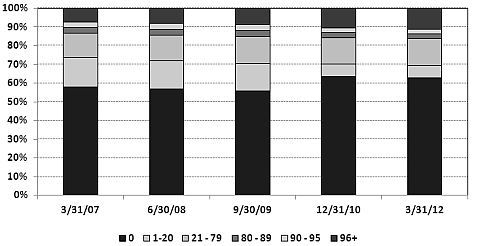Calculated Panel Reactive Antibody (CPRA) after 2.5 Years: More Extremely Sensitized Kidney Waitlist Registrants but Fewer Organ Refusals for a Positive Crossmatch
UCSF, San Francisco, CA
UNOS, Richmond, VA
Stanford, Palo Alto, CA
Cedars-Sinai, Los Angeles, CA
Meeting: 2013 American Transplant Congress
Abstract number: 401
On 10/1/09, the Organ Procurement and Transplantation Network (OPTN) replaced PRA (listed by transplant centers) with CPRA which is calculated using the unacceptable antigens (UA) for each kidney registrant and the corresponding HLA frequencies for deceased donors. The impact of CPRA implementation on sensitization and kidney allocation is presented on behalf of OPTN Histocompatibility Committee.
OPTN data for PRA/CPRA of adult kidney alone registrants were tabulated on 3/31/07, 6/30/08, 9/30/09, 12/31/10, 3/31/12. PRA/CPRA was categorized: 0% (includes not reported), 1-20, 21-79, 80-89, 90-95, and ≥96%. Kidney offers and transplants were tabulated from 4 eras: (1) 4/1/07-6/30/08, (2) 7/1/08-9/30/09, (3) 10/1/09-12/31/10, and (4) 1/1/11-3/31/12.
After 9/30/09, the proportion of registrants with CPRAs of 0% and ≥96% increased and 1-20% decreased (Fig 1).
Fig. 1. PRA/CPRA Distribution of Waiting List Registrations

Regraft candidates consistently had higher PRA/CPRA than primary graft candidates and CPRAs were higher in 2012 than PRAs in 2007 (for ≥80% group PRA/CPRA increased from 43% to 59% and for ≥96% group increased from 26% to 45% of candidates, respectively).
Before and after CPRA implementation, offers refused for a positive crossmatch (xm) decreased dramatically (25,108 in the first era to 5,748 in the last era). During 15 mo prior to CPRA implementation, offers refused for a positive xm decreased by 28% and refusals continued to decrease after implementation (65% during 1st 15 mo and 9% during next 15 mo). After CPRA implementation the proportion of kidneys transplanted into recipients >80% CPRA increased (10% in era 1, 13% in era 2 and 16% in eras 3 and 4).
CPRA implementation has altered PRA/CPRA distribution, particularly for regraft candidates. The distribution of CPRAs was relatively stable from 12/31/10 to 3/31/12. After CPRA implementation there was a substantial reduction of offers refused for a positive xm and more kidneys were transplanted into highly sensitized recipients.
To cite this abstract in AMA style:
Baxter-Lowe L, Kucheryavaya A, Tyan D, Reinsmoen N. Calculated Panel Reactive Antibody (CPRA) after 2.5 Years: More Extremely Sensitized Kidney Waitlist Registrants but Fewer Organ Refusals for a Positive Crossmatch [abstract]. Am J Transplant. 2013; 13 (suppl 5). https://atcmeetingabstracts.com/abstract/calculated-panel-reactive-antibody-cpra-after-2-5-years-more-extremely-sensitized-kidney-waitlist-registrants-but-fewer-organ-refusals-for-a-positive-crossmatch/. Accessed July 18, 2025.« Back to 2013 American Transplant Congress
